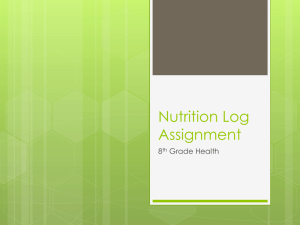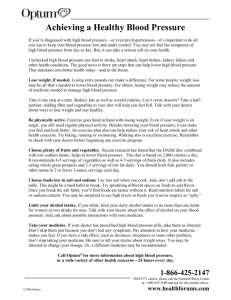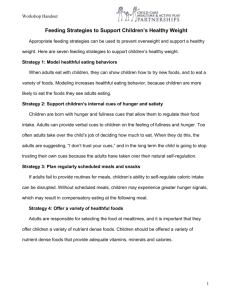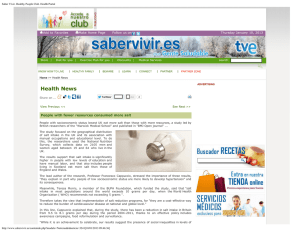Letter to the Editor
advertisement
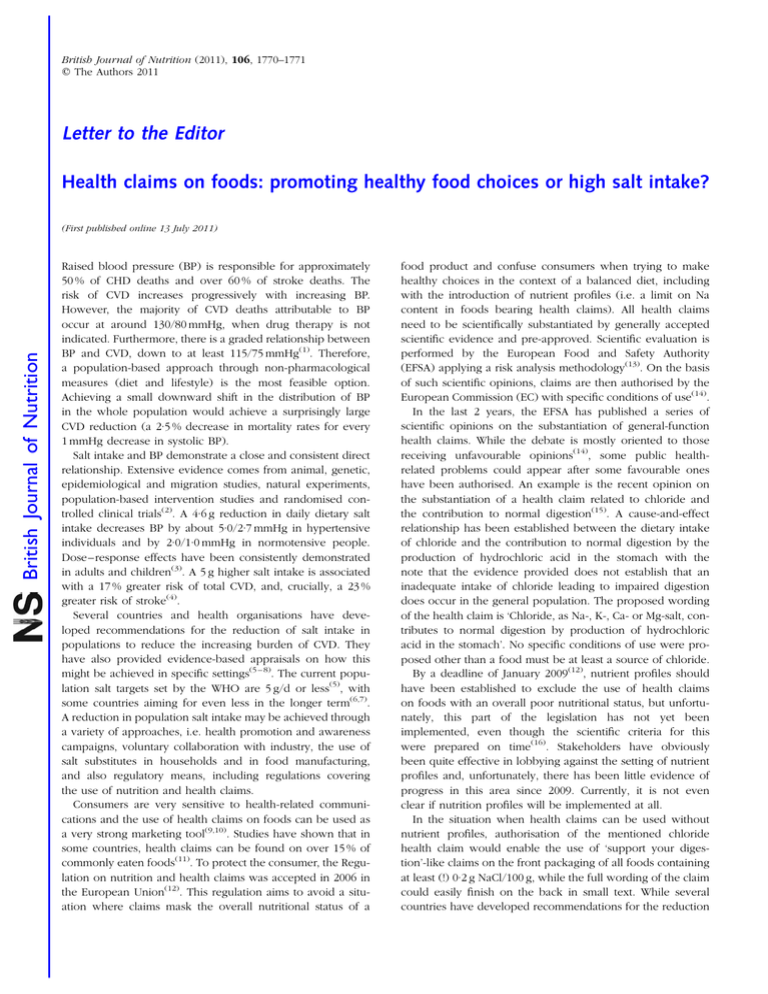
British Journal of Nutrition (2011), 106, 1770–1771 q The Authors 2011 Letter to the Editor Health claims on foods: promoting healthy food choices or high salt intake? British Journal of Nutrition (First published online 13 July 2011) Raised blood pressure (BP) is responsible for approximately 50 % of CHD deaths and over 60 % of stroke deaths. The risk of CVD increases progressively with increasing BP. However, the majority of CVD deaths attributable to BP occur at around 130/80 mmHg, when drug therapy is not indicated. Furthermore, there is a graded relationship between BP and CVD, down to at least 115/75 mmHg(1). Therefore, a population-based approach through non-pharmacological measures (diet and lifestyle) is the most feasible option. Achieving a small downward shift in the distribution of BP in the whole population would achieve a surprisingly large CVD reduction (a 2·5 % decrease in mortality rates for every 1 mmHg decrease in systolic BP). Salt intake and BP demonstrate a close and consistent direct relationship. Extensive evidence comes from animal, genetic, epidemiological and migration studies, natural experiments, population-based intervention studies and randomised controlled clinical trials(2). A 4·6 g reduction in daily dietary salt intake decreases BP by about 5·0/2·7 mmHg in hypertensive individuals and by 2·0/1·0 mmHg in normotensive people. Dose– response effects have been consistently demonstrated in adults and children(3). A 5 g higher salt intake is associated with a 17 % greater risk of total CVD, and, crucially, a 23 % greater risk of stroke(4). Several countries and health organisations have developed recommendations for the reduction of salt intake in populations to reduce the increasing burden of CVD. They have also provided evidence-based appraisals on how this might be achieved in specific settings(5 – 8). The current population salt targets set by the WHO are 5 g/d or less(5), with some countries aiming for even less in the longer term(6,7). A reduction in population salt intake may be achieved through a variety of approaches, i.e. health promotion and awareness campaigns, voluntary collaboration with industry, the use of salt substitutes in households and in food manufacturing, and also regulatory means, including regulations covering the use of nutrition and health claims. Consumers are very sensitive to health-related communications and the use of health claims on foods can be used as a very strong marketing tool(9,10). Studies have shown that in some countries, health claims can be found on over 15 % of commonly eaten foods(11). To protect the consumer, the Regulation on nutrition and health claims was accepted in 2006 in the European Union(12). This regulation aims to avoid a situation where claims mask the overall nutritional status of a food product and confuse consumers when trying to make healthy choices in the context of a balanced diet, including with the introduction of nutrient profiles (i.e. a limit on Na content in foods bearing health claims). All health claims need to be scientifically substantiated by generally accepted scientific evidence and pre-approved. Scientific evaluation is performed by the European Food and Safety Authority (EFSA) applying a risk analysis methodology(13). On the basis of such scientific opinions, claims are then authorised by the European Commission (EC) with specific conditions of use(14). In the last 2 years, the EFSA has published a series of scientific opinions on the substantiation of general-function health claims. While the debate is mostly oriented to those receiving unfavourable opinions(14), some public healthrelated problems could appear after some favourable ones have been authorised. An example is the recent opinion on the substantiation of a health claim related to chloride and the contribution to normal digestion(15). A cause-and-effect relationship has been established between the dietary intake of chloride and the contribution to normal digestion by the production of hydrochloric acid in the stomach with the note that the evidence provided does not establish that an inadequate intake of chloride leading to impaired digestion does occur in the general population. The proposed wording of the health claim is ‘Chloride, as Na-, K-, Ca- or Mg-salt, contributes to normal digestion by production of hydrochloric acid in the stomach’. No specific conditions of use were proposed other than a food must be at least a source of chloride. By a deadline of January 2009(12), nutrient profiles should have been established to exclude the use of health claims on foods with an overall poor nutritional status, but unfortunately, this part of the legislation has not yet been implemented, even though the scientific criteria for this were prepared on time(16). Stakeholders have obviously been quite effective in lobbying against the setting of nutrient profiles and, unfortunately, there has been little evidence of progress in this area since 2009. Currently, it is not even clear if nutrition profiles will be implemented at all. In the situation when health claims can be used without nutrient profiles, authorisation of the mentioned chloride health claim would enable the use of ‘support your digestion’-like claims on the front packaging of all foods containing at least (!) 0·2 g NaCl/100 g, while the full wording of the claim could easily finish on the back in small text. While several countries have developed recommendations for the reduction Letter to the Editor of salt intake in populations, our concern is that use of such claims may not only encourage consumers to increase their consumption of Na-rich foods (through high NaCl consumption) and mislead them about making healthy food choices, but also encourage the producers of foods and food supplements to increase NaCl contents to a level that enables such claims to be made. Both health and ethical concerns arise as to whether such claims about chloride should be allowed and, to protect the consumer, such questions should be carefully addressed by the risk manager and regulator (EC). The following two options could be feasible in this particular case: either reject the claim on the basis of the possible risks of increasing NaCl intake (common salt), or authorise the claim with more specific conditions of use, i.e. preventing its use on foods which are a source of Na. References 1. 2. 3. 4. 5. 6. British Journal of Nutrition Authors’ disclosure statement F. P. C. is an unpaid member of Consensus Action on Salt & Health and World Action on Salt & Health, technical advisor to the WHO and the Pan-American Health Organization and a Member of the Executive Committee and Trustee of the British Hypertension Society. The publication does not necessarily represent the decisions or the stated policy of the WHO and the designations employed and the presentation of material do not imply the expression of any opinion on the part of the WHO. I. P. has no conflict of interest. Francesco P. Cappuccio University of Warwick World Health Organization Collaborating Centre for Nutrition UHCW Campus Clifford Bridge Road Coventry CV2 2DX UK email f.p.cappuccio@warwick.ac.uk 7. 8. 9. 10. 11. 12. 13. 14. Igor Pravst 15. Nutrition Institute Vodnikova cesta 126 SI-1000 Ljubljana Slovenia email igor.pravst@nutris.org 16. doi:10.1017/S0007114511002856 1771 Lewington S, Clarke R, Qizilbash N, et al. (2002) Age-specific relevance of usual blood pressure to vascular mortality: a meta-analysis of individual data for one million adults in 61 prospective studies. Lancet 360, 1903 –1919. He FJ & MacGregor GA (2010) Reducing population salt intake worldwide: from evidence to implementation. Prog Cardiovasc Dis 52, 363– 382. He FJ & MacGregor GA (2003) How far should salt intake be reduced? Hypertension. Hypertension 42, 1093 –1099. Strazzullo P, D’Elia L, Kandala N-B, et al. (2009) Salt intake, stroke and cardiovascular disease: a meta-analysis of prospective studies. Br Med J 339, b4567. WHO (2007) Reducing Salt Intake in Populations: Report of a WHO Forum and Technical Meeting. Geneva: WHO. NICE (2010) Prevention of Cardiovascular Disease at Population Level. NICE Public Health Guidance 25. http:// guidance.nice.org.uk/PH25 (accessed 28 March 2011). London: National Institute for Health and Clinical Excellence. IOM (2010) Strategies to Reduce Sodium Intake. Washington, DC: Institute of Medicine, National Academies Press. Ministry of Health of Canada (2010) Sodium Reduction Strategy for Canada. Canada: Ministry of Health of Canada. Leathwood PD, Richardson DP, Strater P, et al. (2007) Consumer understanding of nutrition and health claims: sources of evidence. Br J Nutr 98, 474– 484. Dean M, Lahteenmaki L & Shepherd R (2011) Nutrition communication: consumer perceptions and predicting intentions. Proc Nutr Soc 70, 19– 25. Lalor F, Kennedy J, Flynn MA, et al. (2010) A study of nutrition and health claims: a snapshot of what’s on the Irish market. Public Health Nutr 13, 704–711. EC (2006) Regulation (EC) no. 1924/2006 on nutrition and health claims made on food. Szajkowska A (2009) From mutual recognition to mutual scientific opinion? Constitutional framework for risk analysis in EU food safety law. Food Policy 34, 529–538. Pravst I (2010) The evaluation of health claims in Europe: what have we learned? AgroFOOD industry hi-tech 21(4), 4– 6. EFSA (2010) Scientific Opinion on the substantiation of health claims related to chloride as Na-, K-, Ca-, or Mg-salt and contribution to normal digestion by production of hydrochloric acid in the stomach (ID 326) pursuant to Article 13(1) of Regulation (EC) No. 1924/2006. EFSA J 8, 1764. EFSA (2008) The setting of nutrient profiles for foods bearing nutrition and health claims pursuant to Article 4 of the Regulation (EC) No. 1924/2006. EFSA J 644, 1 – 44.


